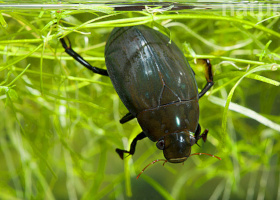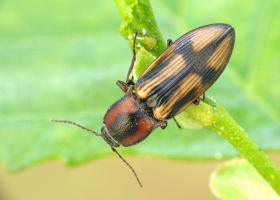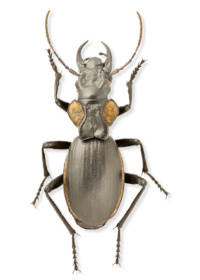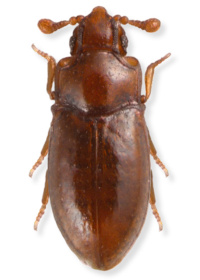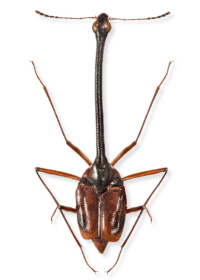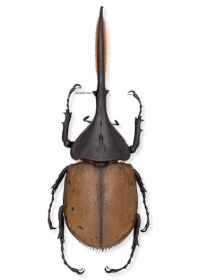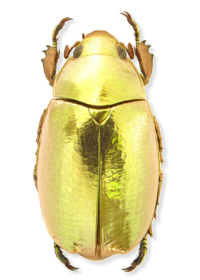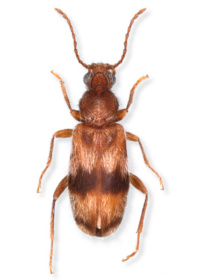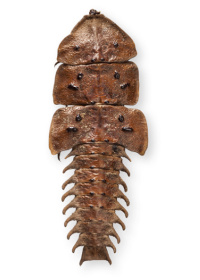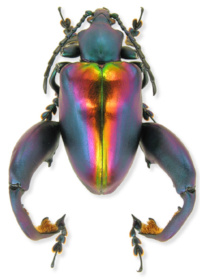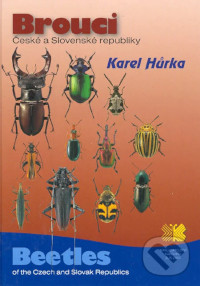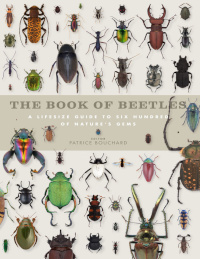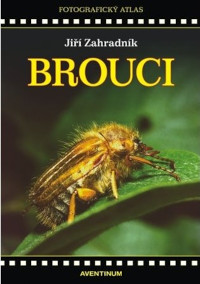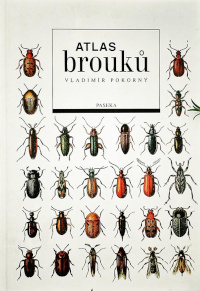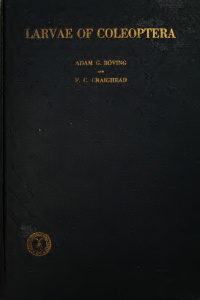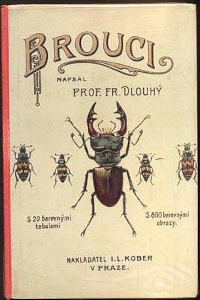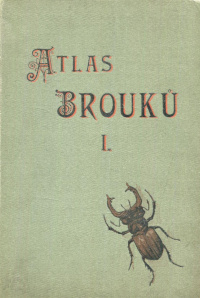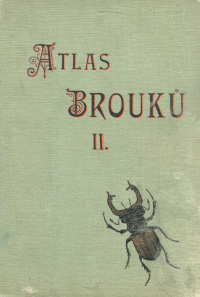Kingdom Animals (Animalia) > Phylum Arthropods (Arthropoda) > Subphylum Hexapod (Hexapoda) > Class Insect (Insecta) > Subclass Pterygota (Pterygota) > Order Coleoptera
- Eleuterata (Fabricius, 1775)
- CZ: Brouci
- CZ: Lomenokřídlí
- SK: Chrobáky
- SK: Koleoptéra, koleoptéry
- SK: Hmyz zlomenokridlý
- PL: Chrząszcze
- DE: Die Käfer
- AT: Die Käfer
- HU: Bogarak
- CH: Die Käfer
- FR: Les Coléoptères
- UK: Beetles
- ES: Los coleópteros
- IT: Coleotteri
- RU: Жесткокры́лые
- RU: Жуки́
The name of the taxonomic order, Coleoptera, comes from the Greek koleopteros (κολεόπτερος), given to the group by Aristotle for their elytra, hardened shield-like forewings, from koleos, sheath, and pteron, wing. The English name beetle comes from the Old English word bitela, little biter, related to bītan (to bite), leading to Middle English betylle. Another Old English name for beetle is ċeafor, chafer, used in names such as cockchafer, from the Proto-Germanic *kebrô ("beetle"; compare German Käfer, Dutch kever, Afrikaans kewer).
Insect order having the wings sheathed by hardened shells, 1763, from Modern Latin, from Greek koleopteros, literally "sheath-wing," used by Aristotle to describe beetles, from koleos "sheath" (from PIE root *kel- (1) "to cover, conceal, save") + pteron "wing" (from PIE root *pet- "to rush, to fly"). Related: Coleopterous; coleopteran; coleopteral.
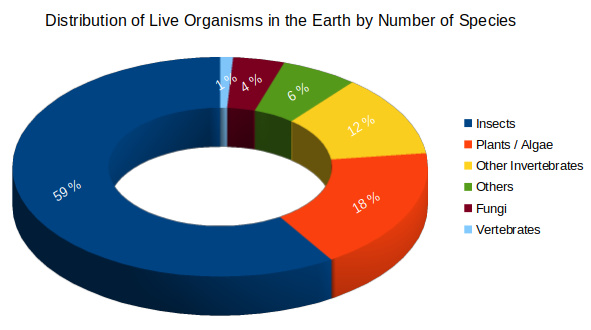 The Coleoptera are the most diverse order of insects, with more than 450,000 described species. Cursory examination of their basic structure may do little to suggest why the group should be so successful, yet they have come to occupy an amazing variety of habitats, with the single exception of the sea, though many littoral species occur. The single most important structural feature contributing to the order’s success has been the development of elytra (sclerotized fore wings), which protect the hind wings when these are not in use and enable the insects to occupy enclosed spaces and cryptic habitats. Other important developments associated with this mode of life include the housing of the coxal segments of the legs in cavities, flattening of the body, and an increase in the proportion of the body surface that is sclerotized, the latter being especially important in protecting the insect from predators and disease. Finally, the spiracles have become hidden in the subelytral cavity, so that water loss from the tracheal system is significantly reduced, allowing the beetles to invade arid environments. Most beetles are phyophagous, including more than 135,000 species in just two superfamilies, Chrysomeloidea and Curculionoidea. The evolution of these two groups, and their species richness, appears to have been closely tied to the evolution of the angiosperms (Farrell, 1998).
The Coleoptera are the most diverse order of insects, with more than 450,000 described species. Cursory examination of their basic structure may do little to suggest why the group should be so successful, yet they have come to occupy an amazing variety of habitats, with the single exception of the sea, though many littoral species occur. The single most important structural feature contributing to the order’s success has been the development of elytra (sclerotized fore wings), which protect the hind wings when these are not in use and enable the insects to occupy enclosed spaces and cryptic habitats. Other important developments associated with this mode of life include the housing of the coxal segments of the legs in cavities, flattening of the body, and an increase in the proportion of the body surface that is sclerotized, the latter being especially important in protecting the insect from predators and disease. Finally, the spiracles have become hidden in the subelytral cavity, so that water loss from the tracheal system is significantly reduced, allowing the beetles to invade arid environments. Most beetles are phyophagous, including more than 135,000 species in just two superfamilies, Chrysomeloidea and Curculionoidea. The evolution of these two groups, and their species richness, appears to have been closely tied to the evolution of the angiosperms (Farrell, 1998).
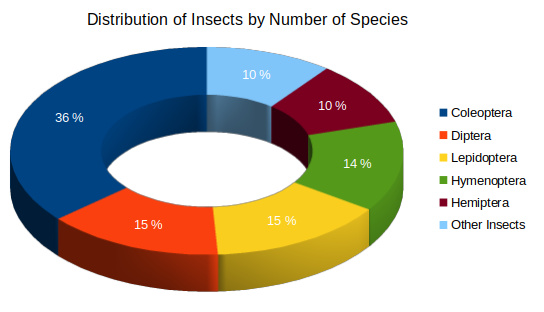 Members of the order Coleoptera comprise the largest order of life. One out of every five species of living things on Earth is a beetle. Beetles live in almost every habitat where insects are found but do not come to the attention of the layperson as often as members of some other orders which are more conspicuous by virtue of their size or habits. The majority of beetles are capable of flight and some fly quite well, but none has adopted the truly aerial lifestyle of butterflies and dragonflies. Most spend the greater part of their lives in cryptic habitats – under bark and in dead wood, in soil and leaf litter, in the water of ponds, lakes, and streams. Although some beetles are among the largest insects, most are quite small; indeed, some are among the smallest of insects. Nevertheless, beetles are unrivaled in their diversity of form and color and in the nearly endless ways they have found to live, feed, and reproduce.
Members of the order Coleoptera comprise the largest order of life. One out of every five species of living things on Earth is a beetle. Beetles live in almost every habitat where insects are found but do not come to the attention of the layperson as often as members of some other orders which are more conspicuous by virtue of their size or habits. The majority of beetles are capable of flight and some fly quite well, but none has adopted the truly aerial lifestyle of butterflies and dragonflies. Most spend the greater part of their lives in cryptic habitats – under bark and in dead wood, in soil and leaf litter, in the water of ponds, lakes, and streams. Although some beetles are among the largest insects, most are quite small; indeed, some are among the smallest of insects. Nevertheless, beetles are unrivaled in their diversity of form and color and in the nearly endless ways they have found to live, feed, and reproduce.
Indicative numbers of representatives of selected taxonomic units in individual regions
| Taxonomic Unit |
Region | |||||||||
| Czech republic |
Central Europe |
Europe | Afrotropical | Australian | Nearctic | Neotropical | Indomalayan (Oriental) |
Palaearctic | World | |
| Order | 1 | 1 | 1 | 1 | 1 | 1 | 1 | 1 | 1 | 1 |
| Suborder | 3 | 3 | 4 | 6 | ||||||
| Infraorder | 8 | 8 | 8 | 8 | ||||||
| Superfamily | 22 | 24 | 28 | 31 | ||||||
| Family | 113 | 114 | 137 | 160 | 150 | 130 | 170 | 170 | 140 | 211 |
| Subfamily | 261 | 541 | ||||||||
| Tribe | 513 | 1 663 | ||||||||
| Genus | 1 707 | 5 415 | ||||||||
| Species | 6 336 | 9 741 | 20 000 | 30 000 | 20 000 | 25 000 | 175 000 | 110 000 | 100 000 | 450 000 |
Zoogeographic Regions
Examples of representatives of the order Coleoptera from the Czech Republic
Examples of representatives of the order Coleoptera from around the world
Checklist (Checklists of the Central European Coleoptera Families)
Taxonomic Atlas (Taxonomic Atlases of the Czech Coleoptera Families)
Alphabetical Atlas (Alphabetical Atlases of the Czech Coleopera Families)
Determination Keys




